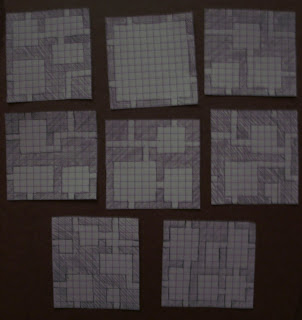Let's think about this for a minute. Dungeon design for miniature use presents some unique challenges. You have to balance the feel of discovery of the unknown with replayability. At one end of the spectrum you have board games with a set single dungeon (like Dungeon) where the only random element is the monster and treasure selection. One the other end you have the room and hall approach favored by most commercial 3D dungeon products like Dwarven Forge.
It would be nice to build a new custom dungeon for every new hole in the ground that my players point their murderous avatars towards, but that's a lot of work. One and done just doesn't cut it for miniature wargaming. The downside of the room and hall approach is the sheer fiddly-ness (fiddle-osity?) of keeping everything together. Those rooms and halls tend to drift apart on the table every time you bump into it.
But there may be another way. What if you used the idea of dungeon geomorphs? These are tiles that always fit together, no matter how you slice them. You can pack rooms and halls together on the same tile and limit the amount of nudging it takes to keep the whole thing together.
So you start with these 8 tiles:
And you can make an awful lot of different dungeons, like so:
Now that I've seen it, though, that dungeon maze just looks too damn busy for my tastes.
[Update: Oh, and the other thing that occurs to me looking at this post, that arrangement of geomorphs gives you an unlimited number of dungeon layouts that all look like the same random collection of rooms and halls. Yuck. The more I look at this, the smarter it looks building a mockup before charging down that dead-end.]
There must be a better way...



Hmm. The geomorphs I've used have been more generic - one per room or corridor section, usually, rather than carrying several rooms on one tile. In its extreme version, you get something like Earth Reborn, but that's distinctly fiddly if there's a risk of the board getting jogged.
ReplyDeleteThe room-and-hall approach works great for the big 25mm figures, but when you're dealing with 10mm figures, things get too fiddly real fast. That's the incentive for having multiple rooms and corridors on a single larger tile. The disincentive is that the more you put on one tile, the less flexibility you have - the less you can make each dungeon unique.
ReplyDeleteI may have found a workable compromise between the two approaches, though. Stay tuned...
This comment has been removed by the author.
ReplyDelete